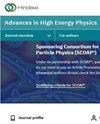通过原子和核过程检测轴子的计算事件率
IF 1.1
4区 物理与天体物理
Q3 PHYSICS, PARTICLES & FIELDS
引用次数: 0
摘要
研究了通过观测轴子诱导的核跃迁和原子跃迁来探测5.5 MeV和14.4 keV太阳轴子的可能性。自旋轨道伙伴之间的核跃迁的存在可以通过随后的伽玛射线发射来证明。跃迁速率也可以在原子核辐射轴子吸收的情况下进行研究。基本相互作用是在现有轴子模型预测的轴子-夸克耦合的背景下得到的。然后,利用合理的现有模型将这些耦合转换到核子水平,从而得到有效的跃迁算子。利用这些算符,我们利用在核壳模型中得到的波函数计算出所需的核矩阵元素。在此基础上,讨论了轴子诱导核伽马射线实验观测的可能性。在第二部分中,我们将研究从深度束缚电子轨道产生的轴-光子转换或电离。在这种情况下,用现有的轴子模型来预测轴子-电子耦合;不需要重整。实验信号是观察到的直接产生的电子和/或发射的硬x射线和俄歇电子,在最后的原子去激发。重点讨论了用多吨尺度NaI探测器探测太阳轴子的实验可行性。本文章由计算机程序翻译,如有差异,请以英文原文为准。
Calculated Event Rates for Axion Detection via Atomic and Nuclear Processes
The possibility of detection of 5.5 MeV and 14.4 keV solar axions by observing axion-induced nuclear and atomic transitions is investigated. The presence of nuclear transitions between spin orbit partners can be manifested by the subsequent deexcitation via gamma ray emissions. The transition rates can also be studied in the context of radiative axion absorption by a nucleus. The elementary interaction is obtained in the context of the axion-quark couplings predicted by existing axion models. Then, these couplings will be transformed to the nucleon level utilizing reasonable existing models, which lead to effective transition operators. Using these operators, we calculate the needed nuclear matrix elements employing wave functions obtained in the context of the nuclear shell model. With these ingredients, we discuss possibilities of experimental observation of the axion-induced nuclear gamma rays. In the second part, we will examine the axion-induced production of X-rays (axion-photon conversion) or ionization from deeply bound electron orbits. In this case, the axion electron coupling is predicted by existing axion models; no renormalization is needed. The experimental signal is the observation of directly produced electrons and/or the emission of hard X-rays and Auger electrons, following the deexcitation of the final atom. Critical discussion is made on the experimental feasibility of detecting the solar axions by using multiton scale NaI detectors.
求助全文
通过发布文献求助,成功后即可免费获取论文全文。
去求助
来源期刊

Advances in High Energy Physics
PHYSICS, PARTICLES & FIELDS-
CiteScore
3.40
自引率
5.90%
发文量
55
审稿时长
6-12 weeks
期刊介绍:
Advances in High Energy Physics publishes the results of theoretical and experimental research on the nature of, and interaction between, energy and matter. Considering both original research and focussed review articles, the journal welcomes submissions from small research groups and large consortia alike.
 求助内容:
求助内容: 应助结果提醒方式:
应助结果提醒方式:


